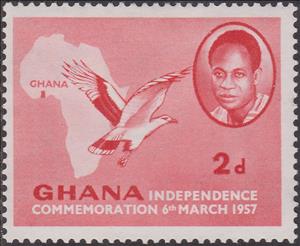Stamp: Kwame Nkrumah (1909-1972), Primeminister, Vulture, Map (Ghana 1957)
Kwame Nkrumah (1909-1972), Primeminister, Vulture, Map (Ghana 1957)
06 March (Ghana ) within release Independence Commemoration goes into circulation Stamp Kwame Nkrumah (1909-1972), Primeminister, Vulture, Map face value 2 Ghanaian penny
| Stamp Kwame Nkrumah (1909-1972), Primeminister, Vulture, Map in catalogues | |
|---|---|
| Michel: | Mi:GH 1 |
| Stamp Number: | Sn:GH 1 |
| Yvert et Tellier: | Yt:GH 10 |
Stamp is horizontal format.
Also in the issue Independence Commemoration:
- Stamp - Kwame Nkrumah (1909-1972), Primeminister, Vulture, Map face value 2;
- Stamp - Kwame Nkrumah (1909-1972), Primeminister, Vulture, Map face value 2½;
- Stamp - Kwame Nkrumah (1909-1972), Primeminister, Vulture, Map face value 4;
- Stamp - Kwame Nkrumah (1909-1972), Primeminister, Vulture, Map face value 1'3;
Stamp Kwame Nkrumah (1909-1972), Primeminister, Vulture, Map it reflects the thematic directions:
A head of state (or chief of state) is the public persona that officially represents the national unity and legitimacy of a sovereign state. In some countries, the head of state is a ceremonial figurehead with limited or no executive power, while in others, the head of state is also the head of government. In countries with parliamentary governments, the head of state is typically a ceremonial figurehead that does not actually guide day-to-day government activities and may not be empowered to exercise any kind of secular political authority (e.g., Queen Elizabeth II as Head of the Commonwealth). In countries where the head of state is also the head of government, the president serves as both a public figurehead and the actual highest ranking political leader who oversees the executive branch (e.g., the President of the United States).
A map is a symbolic depiction emphasizing relationships between elements of some space, such as objects, regions, or themes. Many maps are static, fixed to paper or some other durable medium, while others are dynamic or interactive. Although most commonly used to depict geography, maps may represent any space, real or imagined, without regard to context or scale, such as in brain mapping, DNA mapping, or computer network topology mapping. The space being mapped may be two dimensional, such as the surface of the earth, three dimensional, such as the interior of the earth, or even more abstract spaces of any dimension, such as arise in modeling phenomena having many independent variables. Although the earliest maps known are of the heavens, geographic maps of territory have a very long tradition and exist from ancient times. The word "map" comes from the medieval Latin Mappa mundi, wherein mappa meant napkin or cloth and mundi the world. Thus, "map" became the shortened term referring to a two-dimensional representation of the surface of the world.
Birds (Aves), a subgroup of Reptiles, are the last living examples of Dinosaurs. They are a group of endothermic vertebrates, characterised by feathers, toothless beaked jaws, the laying of hard-shelled eggs, a high metabolic rate, a four-chambered heart, and a strong yet lightweight skeleton. Birds live worldwide and range in size from the 5 cm (2 in) bee hummingbird to the 2.75 m (9 ft) ostrich. They rank as the class of tetrapods with the most living species, at approximately ten thousand, with more than half of these being passerines, sometimes known as perching birds. Birds are the closest living relatives of crocodilians.
Birds of prey or predatory birds, also known as raptors, are hypercarnivorous bird species that actively hunt and feed on other vertebrates (mainly mammals, reptiles and smaller birds). In addition to speed and strength, these predators have keen eyesight for detecting prey from a distance or during flight, strong feet with sharp talons for grasping or killing prey, and powerful, curved beaks for tearing off flesh. Although predatory birds primarily hunt live prey, many species (such as fish eagles, vultures and condors) also scavenge and eat carrion
Animals are multicellular, eukaryotic organisms of the kingdom Animalia (also called Metazoa). All animals are motile, meaning they can move spontaneously and independently, at some point in their lives. Their body plan eventually becomes fixed as they develop, although some undergo a process of metamorphosis later on in their lives. All animals are heterotrophs: they must ingest other organisms or their products for sustenance.





